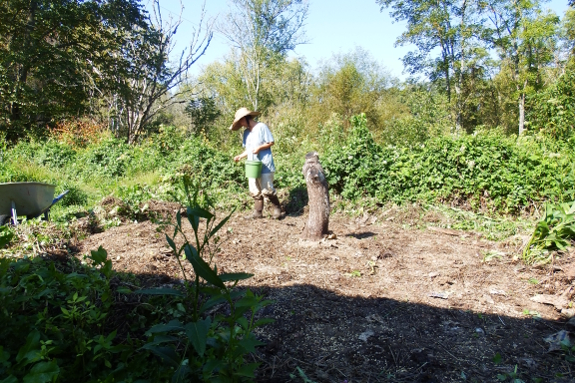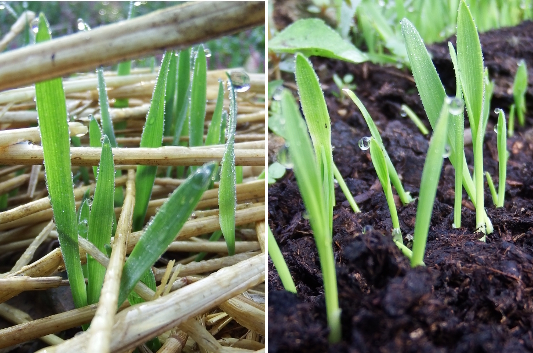
Last week of oats

This is the final week
for oat planting in our neck of the woods, so
we're filling up as many garden spots as can easily be turned over to
cover crops. In really poor soil that
didn't produce as well as I would
have liked this summer, I sprinkle the oat seeds over the ground then
top them off with solid coating of composted horse manure. Richer soil
gets less TLC --- just oats covered by a thin layer of straw meant to
hold in moisture and confuse hungry birds.

Add a little water and
the seeds sprout fast. The image above shows
oats we planted last week in parched soil, then watered well with our
impact sprinklers.
Given my continued
health issues, I'm not hitting every bed I'd really
want to with oats this year. But that's okay --- rye can be planted
slowly but surely over the next month and a half to produce similar
cover and biomass. The goats don't enjoy grazing rye as much and the
rye beds won't be available for spring and early summer planting, but
the
soil won't mind at all getting to enjoy eight months off covered with
rye.
Want more in-depth information? Browse through our books.
Or explore more posts by date or by subject.
About us: Anna Hess and Mark Hamilton spent over a decade living self-sufficiently in the mountains of Virginia before moving north to start over from scratch in the foothills of Ohio. They've experimented with permaculture, no-till gardening, trailersteading, home-based microbusinesses and much more, writing about their adventures in both blogs and books.
Want to be notified when new comments are posted on this page? Click on the RSS button after you add a comment to subscribe to the comment feed, or simply check the box beside "email replies to me" while writing your comment.

Hi Anna and Mark,
I did hair trace mineral analysis on both my late wife and I. Very similar data?
Our shortages matched the local soil!
I add 1 teaspoon of Redmond clay to my toast most mornings to try to help with these and other hidden trace mineral shortages.
A Logan Labs Agridyne III test of your local soil might be worthwhile to check for any micro and nano trace mineral shortages you discover.
Another interesting tidbit I discovered: A believed to be important ingredient in many medicinal herbs is Germanium 132. Only there I assume if the soil also has Ge. Not tested for by most labs as far as I know.
warm regards to you both, John
You should be careful with germanium compounds such as Ge-132 (and indeed with many organometallic compounds).
Looking at the literature, mammals do not seem to require Germanium in their diet; it's not an essential trace element.
It is estimated that we take in approximately 1.5 mg of Germanium per day from a normal diet. Taking Ge-132 supplements increases that between 100 and 2000 times. This can lead to kidney dysfunction and failure. Over the years, there have been dozens of fatalities. In most cases where people survived kidney function improved after they stopped taking the supplement. However in general this recovery is not complete, and the people involved have to live the rest of their lives with reduced kidney function.
Many organometallic compounds are highly toxic or otherwise dangerous, especially those that are volatile, e.g. combinations of a methyl or ethyl group with a metal atom. Dimethylmercury is one of the strongest known neurotoxins (a couple of drops on the skin can kill you). Diethylzinc and trimethylaluminium burst into flames when exposed to air.
Hi Roland and Anna and Mark and All,
The reference is:
Development and Uses of Biofortified Agricultural Products by Gary S. Banuelos and Zhi-Qing Lin CRC Press.
Page 273: 16.4.2 - Plant Germanium and Biological Functions
This reference does talk about the dangers of inorganic Ge.
It also references Asai 1981 for the high organic Ge content measurements in Ginseng.
"...commonly named as Ge-132, as a form of organically bound Ge that is virtually nontoxic to humans."
Its a pretty good read. I got it through inter-library loan here [Concord, NH].
Pretty thought provoking :))))).
So yes, the organic compound Ge-132 is bioactive and health producing at least according to this author.
Gotta wonder how many other organic compounds there are yet to be discovered?
John